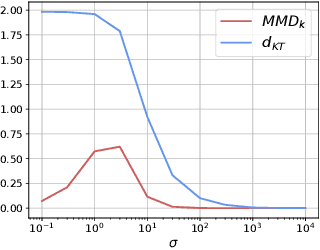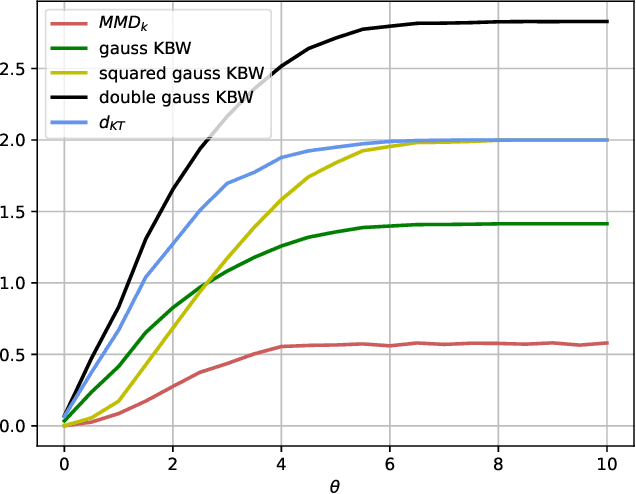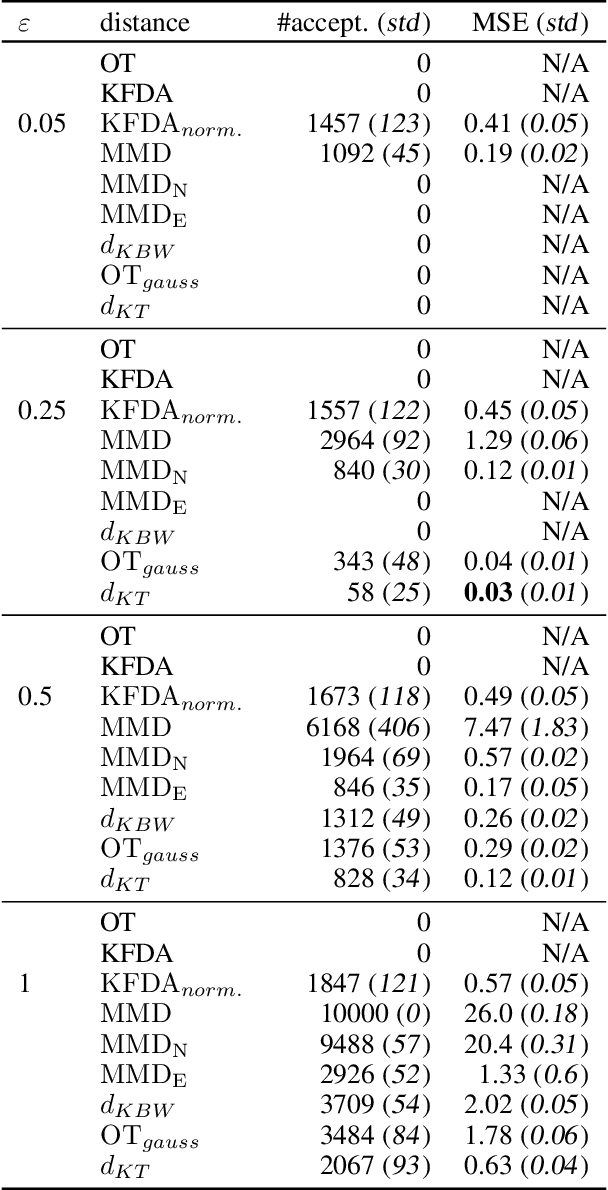Anna Korba
Kernel Trace Distance: Quantum Statistical Metric between Measures through RKHS Density Operators
Jul 08, 2025



Abstract:Distances between probability distributions are a key component of many statistical machine learning tasks, from two-sample testing to generative modeling, among others. We introduce a novel distance between measures that compares them through a Schatten norm of their kernel covariance operators. We show that this new distance is an integral probability metric that can be framed between a Maximum Mean Discrepancy (MMD) and a Wasserstein distance. In particular, we show that it avoids some pitfalls of MMD, by being more discriminative and robust to the choice of hyperparameters. Moreover, it benefits from some compelling properties of kernel methods, that can avoid the curse of dimensionality for their sample complexity. We provide an algorithm to compute the distance in practice by introducing an extension of kernel matrix for difference of distributions that could be of independent interest. Those advantages are illustrated by robust approximate Bayesian computation under contamination as well as particle flow simulations.
Variational Inference with Mixtures of Isotropic Gaussians
Jun 16, 2025Abstract:Variational inference (VI) is a popular approach in Bayesian inference, that looks for the best approximation of the posterior distribution within a parametric family, minimizing a loss that is typically the (reverse) Kullback-Leibler (KL) divergence. In this paper, we focus on the following parametric family: mixtures of isotropic Gaussians (i.e., with diagonal covariance matrices proportional to the identity) and uniform weights. We develop a variational framework and provide efficient algorithms suited for this family. In contrast with mixtures of Gaussian with generic covariance matrices, this choice presents a balance between accurate approximations of multimodal Bayesian posteriors, while being memory and computationally efficient. Our algorithms implement gradient descent on the location of the mixture components (the modes of the Gaussians), and either (an entropic) Mirror or Bures descent on their variance parameters. We illustrate the performance of our algorithms on numerical experiments.
Flowing Datasets with Wasserstein over Wasserstein Gradient Flows
Jun 09, 2025Abstract:Many applications in machine learning involve data represented as probability distributions. The emergence of such data requires radically novel techniques to design tractable gradient flows on probability distributions over this type of (infinite-dimensional) objects. For instance, being able to flow labeled datasets is a core task for applications ranging from domain adaptation to transfer learning or dataset distillation. In this setting, we propose to represent each class by the associated conditional distribution of features, and to model the dataset as a mixture distribution supported on these classes (which are themselves probability distributions), meaning that labeled datasets can be seen as probability distributions over probability distributions. We endow this space with a metric structure from optimal transport, namely the Wasserstein over Wasserstein (WoW) distance, derive a differential structure on this space, and define WoW gradient flows. The latter enables to design dynamics over this space that decrease a given objective functional. We apply our framework to transfer learning and dataset distillation tasks, leveraging our gradient flow construction as well as novel tractable functionals that take the form of Maximum Mean Discrepancies with Sliced-Wasserstein based kernels between probability distributions.
DDEQs: Distributional Deep Equilibrium Models through Wasserstein Gradient Flows
Mar 03, 2025Abstract:Deep Equilibrium Models (DEQs) are a class of implicit neural networks that solve for a fixed point of a neural network in their forward pass. Traditionally, DEQs take sequences as inputs, but have since been applied to a variety of data. In this work, we present Distributional Deep Equilibrium Models (DDEQs), extending DEQs to discrete measure inputs, such as sets or point clouds. We provide a theoretically grounded framework for DDEQs. Leveraging Wasserstein gradient flows, we show how the forward pass of the DEQ can be adapted to find fixed points of discrete measures under permutation-invariance, and derive adequate network architectures for DDEQs. In experiments, we show that they can compete with state-of-the-art models in tasks such as point cloud classification and point cloud completion, while being significantly more parameter-efficient.
Properties of Wasserstein Gradient Flows for the Sliced-Wasserstein Distance
Feb 10, 2025Abstract:In this paper, we investigate the properties of the Sliced Wasserstein Distance (SW) when employed as an objective functional. The SW metric has gained significant interest in the optimal transport and machine learning literature, due to its ability to capture intricate geometric properties of probability distributions while remaining computationally tractable, making it a valuable tool for various applications, including generative modeling and domain adaptation. Our study aims to provide a rigorous analysis of the critical points arising from the optimization of the SW objective. By computing explicit perturbations, we establish that stable critical points of SW cannot concentrate on segments. This stability analysis is crucial for understanding the behaviour of optimization algorithms for models trained using the SW objective. Furthermore, we investigate the properties of the SW objective, shedding light on the existence and convergence behavior of critical points. We illustrate our theoretical results through numerical experiments.
Density Ratio Estimation with Conditional Probability Paths
Feb 04, 2025Abstract:Density ratio estimation in high dimensions can be reframed as integrating a certain quantity, the time score, over probability paths which interpolate between the two densities. In practice, the time score has to be estimated based on samples from the two densities. However, existing methods for this problem remain computationally expensive and can yield inaccurate estimates. Inspired by recent advances in generative modeling, we introduce a novel framework for time score estimation, based on a conditioning variable. Choosing the conditioning variable judiciously enables a closed-form objective function. We demonstrate that, compared to previous approaches, our approach results in faster learning of the time score and competitive or better estimation accuracies of the density ratio on challenging tasks. Furthermore, we establish theoretical guarantees on the error of the estimated density ratio.
Polynomial time sampling from log-smooth distributions in fixed dimension under semi-log-concavity of the forward diffusion with application to strongly dissipative distributions
Dec 31, 2024Abstract:In this article we provide a stochastic sampling algorithm with polynomial complexity in fixed dimension that leverages the recent advances on diffusion models where it is shown that under mild conditions, sampling can be achieved via an accurate estimation of intermediate scores across the marginals $(p_t)_{t\ge 0}$ of the standard Ornstein-Uhlenbeck process started at the density we wish to sample from. The heart of our method consists into approaching these scores via a computationally cheap estimator and relating the variance of this estimator to the smoothness properties of the forward process. Under the assumption that the density to sample from is $L$-log-smooth and that the forward process is semi-log-concave: $-\nabla^2 \log(p_t) \succeq -\beta I_d$ for some $\beta \geq 0$, we prove that our algorithm achieves an expected $\epsilon$ error in $\text{KL}$ divergence in $O(d^7L^{d+2}\epsilon^{-2(d+3)} (L+\beta)^2d^{2(d+1)})$ time. In particular, our result allows to fully transfer the problem of sampling from a log-smooth distribution into a regularity estimate problem. As an application, we derive an exponential complexity improvement for the problem of sampling from a $L$-log-smooth distribution that is $\alpha$-strongly log-concave distribution outside some ball of radius $R$: after proving that such distributions verify the semi-log-concavity assumption, a result which might be of independent interest, we recover a $poly(R,L,\alpha^{-1}, \epsilon^{-1})$ complexity in fixed dimension which exponentially improves upon the previously known $poly(e^{RL^2}, L,\alpha^{-1}, \log(\epsilon^{-1}))$ complexity in the low precision regime.
Constrained Sampling with Primal-Dual Langevin Monte Carlo
Nov 01, 2024Abstract:This work considers the problem of sampling from a probability distribution known up to a normalization constant while satisfying a set of statistical constraints specified by the expected values of general nonlinear functions. This problem finds applications in, e.g., Bayesian inference, where it can constrain moments to evaluate counterfactual scenarios or enforce desiderata such as prediction fairness. Methods developed to handle support constraints, such as those based on mirror maps, barriers, and penalties, are not suited for this task. This work therefore relies on gradient descent-ascent dynamics in Wasserstein space to put forward a discrete-time primal-dual Langevin Monte Carlo algorithm (PD-LMC) that simultaneously constrains the target distribution and samples from it. We analyze the convergence of PD-LMC under standard assumptions on the target distribution and constraints, namely (strong) convexity and log-Sobolev inequalities. To do so, we bring classical optimization arguments for saddle-point algorithms to the geometry of Wasserstein space. We illustrate the relevance and effectiveness of PD-LMC in several applications.
Provable Convergence and Limitations of Geometric Tempering for Langevin Dynamics
Oct 13, 2024Abstract:Geometric tempering is a popular approach to sampling from challenging multi-modal probability distributions by instead sampling from a sequence of distributions which interpolate, using the geometric mean, between an easier proposal distribution and the target distribution. In this paper, we theoretically investigate the soundness of this approach when the sampling algorithm is Langevin dynamics, proving both upper and lower bounds. Our upper bounds are the first analysis in the literature under functional inequalities. They assert the convergence of tempered Langevin in continuous and discrete-time, and their minimization leads to closed-form optimal tempering schedules for some pairs of proposal and target distributions. Our lower bounds demonstrate a simple case where the geometric tempering takes exponential time, and further reveal that the geometric tempering can suffer from poor functional inequalities and slow convergence, even when the target distribution is well-conditioned. Overall, our results indicate that geometric tempering may not help, and can even be harmful for convergence.
Statistical and Geometrical properties of regularized Kernel Kullback-Leibler divergence
Aug 29, 2024



Abstract:In this paper, we study the statistical and geometrical properties of the Kullback-Leibler divergence with kernel covariance operators (KKL) introduced by Bach [2022]. Unlike the classical Kullback-Leibler (KL) divergence that involves density ratios, the KKL compares probability distributions through covariance operators (embeddings) in a reproducible kernel Hilbert space (RKHS), and compute the Kullback-Leibler quantum divergence. This novel divergence hence shares parallel but different aspects with both the standard Kullback-Leibler between probability distributions and kernel embeddings metrics such as the maximum mean discrepancy. A limitation faced with the original KKL divergence is its inability to be defined for distributions with disjoint supports. To solve this problem, we propose in this paper a regularised variant that guarantees that the divergence is well defined for all distributions. We derive bounds that quantify the deviation of the regularised KKL to the original one, as well as finite-sample bounds. In addition, we provide a closed-form expression for the regularised KKL, specifically applicable when the distributions consist of finite sets of points, which makes it implementable. Furthermore, we derive a Wasserstein gradient descent scheme of the KKL divergence in the case of discrete distributions, and study empirically its properties to transport a set of points to a target distribution.
 Add to Chrome
Add to Chrome Add to Firefox
Add to Firefox Add to Edge
Add to Edge